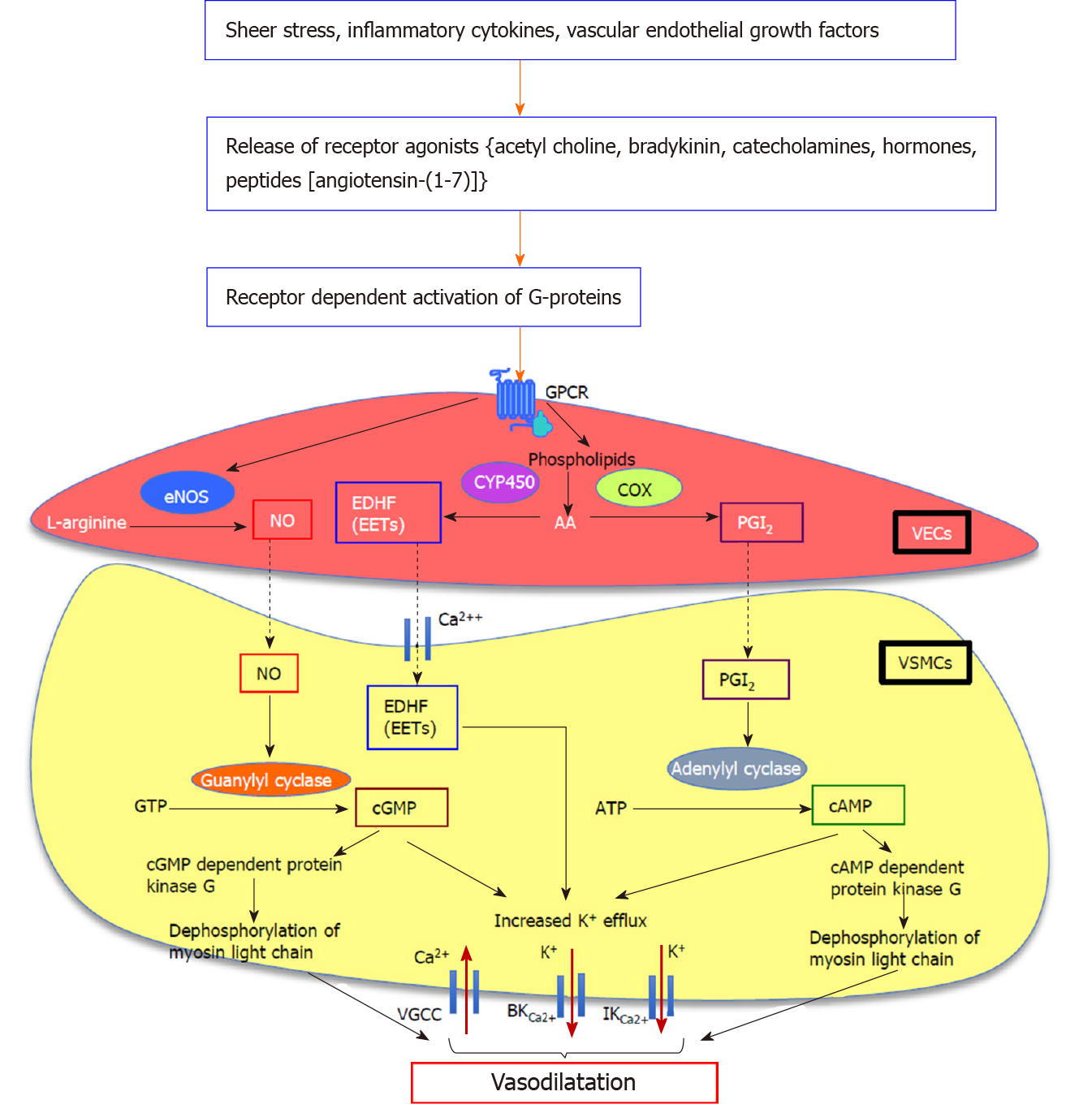Copyright
©The Author(s) 2020.
World J Gastroenterol. Oct 28, 2020; 26(40): 6111-6140
Published online Oct 28, 2020. doi: 10.3748/wjg.v26.i40.6111
Published online Oct 28, 2020. doi: 10.3748/wjg.v26.i40.6111
Figure 1 Proposed downstream signalling pathways of endothelium-dependent vasodilatation in splanchnic vasculature.
Nitric oxide (NO) is a key mediator of mesenteric vasodilatation in cirrhosis. G protein-coupled receptor-mediated activation of G-proteins augments the production and activation of a number of vasodilatory pathways including endothelial nitric oxide synthase/nitric oxide (eNOS/NO), vasodilating prostacyclins, and metabolites of arachidonic acid (AA) metabolism which act as endothelium-derived hyperpolarizing factors such as epoxyeicosatrienoic acids (EETs) in vascular endothelial cells. The eNOS converts L-arginine to produce NO which diffuses into the vascular smooth muscle cells (VSMCs). In VSMCs, NO which activates membrane-bound guanylyl cyclase enzyme to release cyclic guanosine monophosphate from guanosine triphosphate, mediates vasodilatation by increasing K+ efflux via large-conductance and intermediate-conductance calcium-activated potassium channels and by decreasing Ca2+ influx via voltage-gated calcium channels, and by dephosphorylation of myosin light chain. In addition to NO, vasodilators such as prostaglandin I2, derived from AA by the action of cyclooxygenase enzyme which activates membrane-bound adenylyl cyclase enzyme to release cyclic adenosine monophosphate from adenosine triphosphate, causes vasodilatation by increasing K+ efflux and dephosphorylation of myosin light chain. The EETs deriving from AA by the action of endothelial epoxygenases such as cytochrome P450 directly act on Ca2+ and K+ channels, causing hyperpolarization of VSMC membrane and subsequent vasodilatation. NO: Nitric oxide; GPCR: G protein-coupled receptor; eNOS/NO: Endothelial nitric oxide synthase/nitric oxide; AA: Arachidonic acid; EDHFs: Endothelium-derived hyperpolarizing factors; EETs: Epoxyeicosatrienoic acids; VECs: Vascular endothelial cells; VSMCs: Vascular smooth muscle cells; cGMP: Cyclic guanosine monophosphate; GTP: Guanosine triphosphate; BKCa2+: Large-conductance; IKCa2+: Intermediate-conductance; VGCCs: Voltage-gated calcium channels; PGI2: Prostaglandin I2; COX: Cyclooxygenase; cAMP: Cyclic adenosine monophosphate; ATP: Adenosine triphosphate; CYP450: Cytochrome P450.
- Citation: Gunarathne LS, Rajapaksha H, Shackel N, Angus PW, Herath CB. Cirrhotic portal hypertension: From pathophysiology to novel therapeutics. World J Gastroenterol 2020; 26(40): 6111-6140
- URL: https://www.wjgnet.com/1007-9327/full/v26/i40/6111.htm
- DOI: https://dx.doi.org/10.3748/wjg.v26.i40.6111









